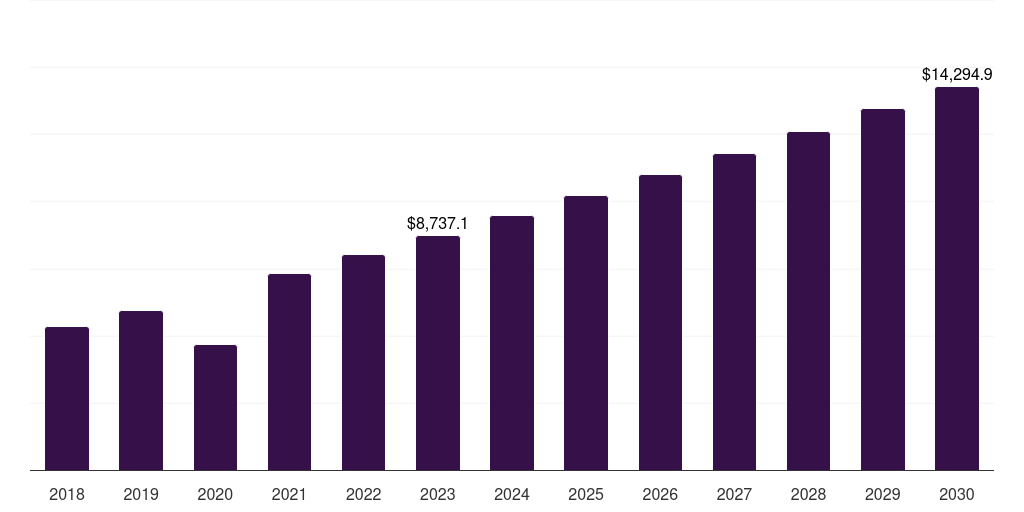Asia Pacific In Vitro Fertilization Market Size & Outlook
Asia Pacific in vitro fertilization market, 2018-2030 (US$M)

Related Markets
Asia Pacific in vitro fertilization market highlights
- The Asia Pacific in vitro fertilization market generated a revenue of USD 8,737.1 million in 2023.
- The market is expected to grow at a CAGR of 7.3% from 2024 to 2030.
- In terms of segment, frozen nondonor was the largest revenue generating procedure type in 2023.
- Fresh Donor is the most lucrative procedure type segment registering the fastest growth during the forecast period.
- Country-wise, India is expected to register the highest CAGR from 2024 to 2030.
Asia Pacific data book summary
| Market revenue in 2023 | USD 8,737.1 million |
| Market revenue in 2030 | USD 14,294.9 million |
| Growth rate | 7.3% (CAGR from 2023 to 2030) |
| Largest segment | Frozen nondonor |
| Fastest growing segment | Fresh Donor |
| Historical data covered | 2018 - 2022 |
| Base year for estimation | 2023 |
| Forecast period covered | 2024 - 2030 |
| Quantitative units | Revenue in USD million |
| Market segmentation | Fresh Nondonor, Frozen Nondonor, Fresh Donor, Frozen Donor |
| Key market players worldwide | Bayer AG, Cook Medical, Merck KGaA, Ferring, FUJIFILM Holdings Corp, Genea Biomedx, Merck & Co Inc, The Cooper Companies Inc, Thermo Fisher Scientific Inc, Vitrolife AB ADR, Boston Scientific Corp, Nova IVF, Fortis Healthcare, RMA Network, TFP Fertility Group, US Fertility |
Other key industry trends
- In terms of revenue, Asia Pacific region accounted for 34.5% of the global in vitro fertilization market in 2023.
- Globally, Asia Pacific is projected to lead the regional market in terms of revenue in 2030.
- Asia Pacific is the fastest growing regional market and is projected to reach USD 14,294.9 million by 2030.
No credit card required*
Horizon in a snapshot
- 30K+ Global Market Reports
- 120K+ Country Reports
- 1.2M+ Market Statistics
- 200K+ Company Profiles
- Industry insights and more
In Vitro Fertilization Market Scope
In Vitro Fertilization Market Companies
| Name | Profile | # Employees | HQ | Website |
|---|
Asia Pacific in vitro fertilization market outlook
The databook is designed to serve as a comprehensive guide to navigating this sector. The databook focuses on market statistics denoted in the form of revenue and y-o-y growth and CAGR across the globe and regions. A detailed competitive and opportunity analyses related to in vitro fertilization market will help companies and investors design strategic landscapes.
Frozen nondonor was the largest segment with a revenue share of 48.39% in 2023. Horizon Databook has segmented the Asia Pacific in vitro fertilization market based on fresh nondonor, frozen nondonor, fresh donor, frozen donor covering the revenue growth of each sub-segment from 2018 to 2030.
The demand for IVF treatments is expected to increase owing to the growth in fertility tourism, increase in the number of international companies trying to penetrate economically developing countries, and change in the regulatory landscape in APAC. The Asia Pacific Initiative on Reproduction (ASPIRE) is a task force of clinicians & scientists engaged in the management of fertility & ART.
This promotes awareness regarding infertility & ART and enhances infertility-related services in the region. According to OECD, in 2022, birth rate in Asia Pacific has fallen to population replacement rate of 2.1 born children per woman. Decrease in birth rate and increase in the geriatric population are among the key factors expected to propel market growth.
This is likely to pose an economic challenge to support aging population. However, it would help cope with the declining birth rate and aid in the replacement of the aging workforce with younger workers. Asian countries such as South Korea, Japan, and Singapore offer partial coverage for ART.
Reasons to subscribe to Asia Pacific in vitro fertilization market databook:
-
Access to comprehensive data: Horizon Databook provides over 1 million market statistics and 20,000+ reports, offering extensive coverage across various industries and regions.
-
Informed decision making: Subscribers gain insights into market trends, customer preferences, and competitor strategies, empowering informed business decisions.
-
Cost-Effective solution: It's recognized as the world's most cost-effective market research database, offering high ROI through its vast repository of data and reports.
-
Customizable reports: Tailored reports and analytics allow companies to drill down into specific markets, demographics, or product segments, adapting to unique business needs.
-
Strategic advantage: By staying updated with the latest market intelligence, companies can stay ahead of competitors, anticipate industry shifts, and capitalize on emerging opportunities.
Target buyers of Asia Pacific in vitro fertilization market databook
-
Our clientele includes a mix of in vitro fertilization market companies, investment firms, advisory firms & academic institutions.
-
30% of our revenue is generated working with investment firms and helping them identify viable opportunity areas.
-
Approximately 65% of our revenue is generated working with competitive intelligence & market intelligence teams of market participants (manufacturers, service providers, etc.).
-
The rest of the revenue is generated working with academic and research not-for-profit institutes. We do our bit of pro-bono by working with these institutions at subsidized rates.
Horizon Databook provides a detailed overview of continent-level data and insights on the Asia Pacific in vitro fertilization market , including forecasts for subscribers. This continent databook contains high-level insights into Asia Pacific in vitro fertilization market from 2018 to 2030, including revenue numbers, major trends, and company profiles.
Partial client list
Asia Pacific in vitro fertilization market size, by country, 2018-2030 (US$M)
Asia Pacific In Vitro Fertilization Market Outlook Share, 2023 & 2030 (US$M)
Related industry reports
Related regional statistics
Sign up - it's easy, and free!
Sign up and get instant basic access to databook, upgrade
when ready, or enjoy our
free plan indefinitely.
Included in Horizon account
- 30K+ Global Market Reports
- 120K+ Country Reports
- 1.2M+ Market Statistics
- 200K+ Company Profiles
- Industry insights and more



